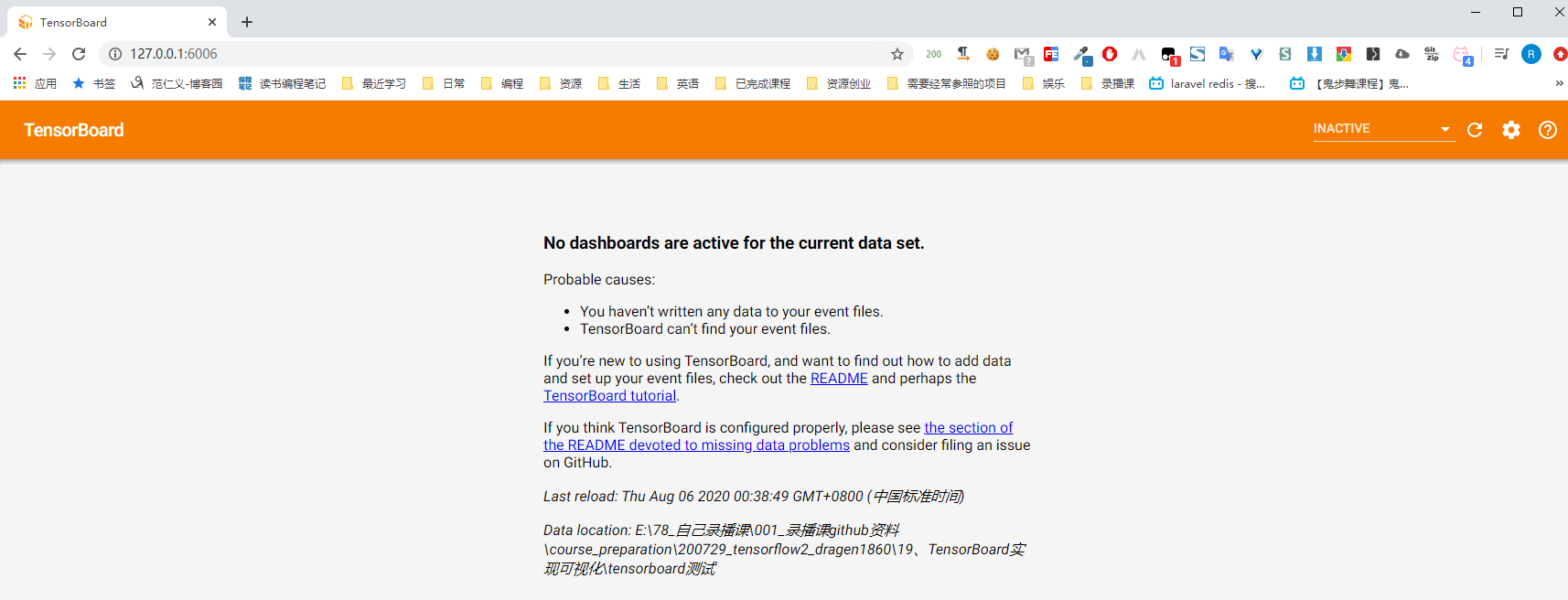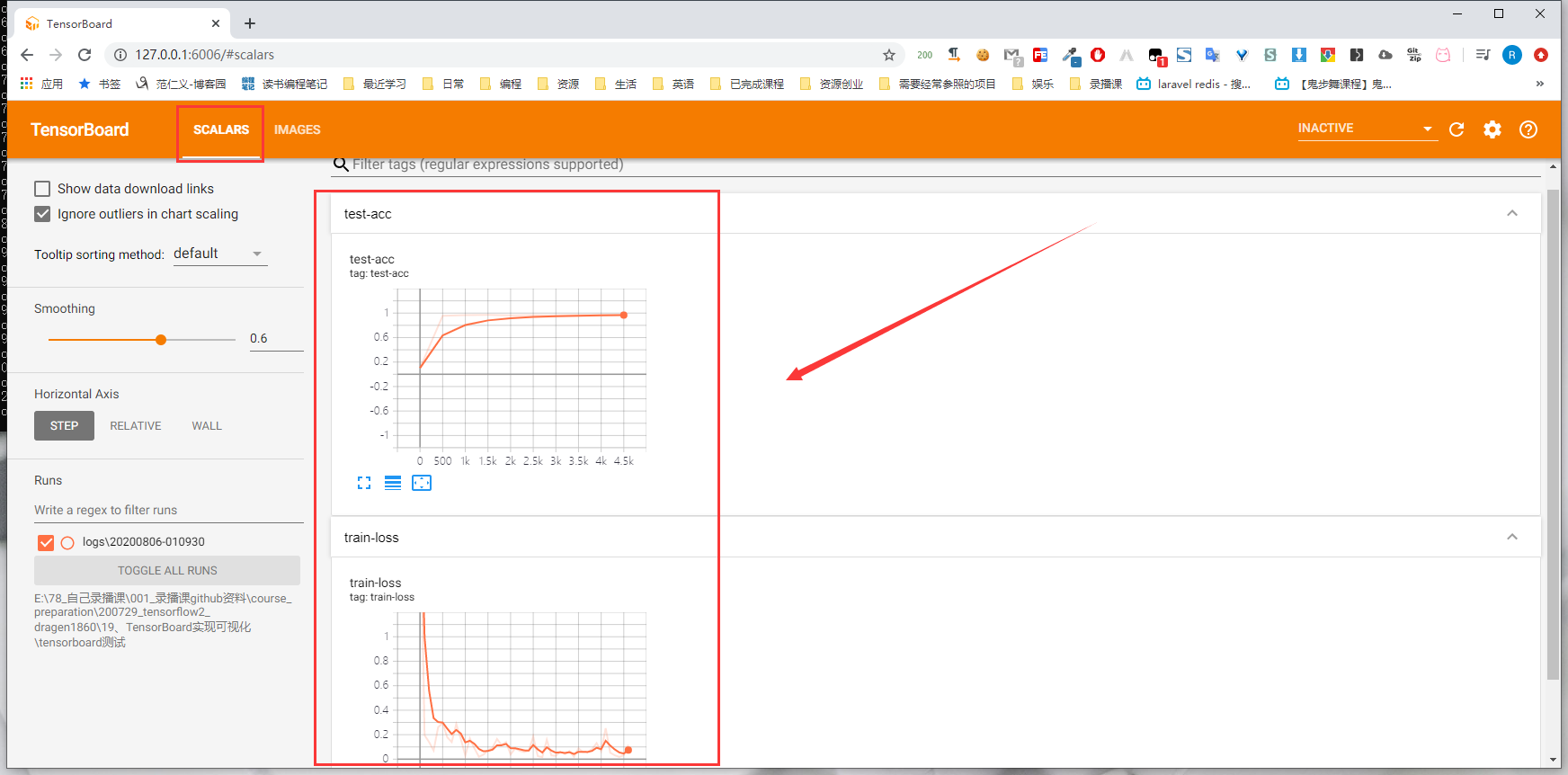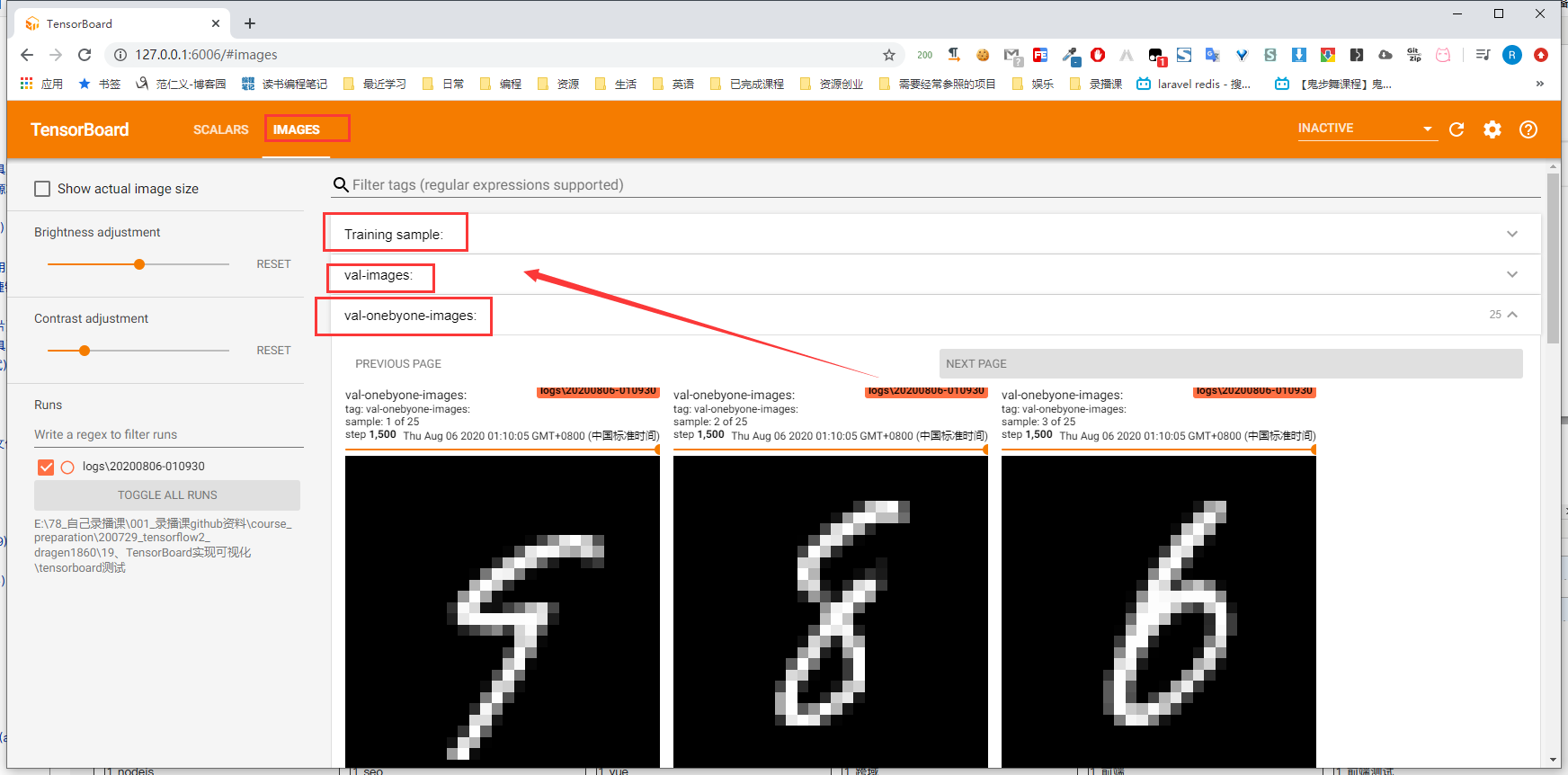Windows下Anaconda中tensorflow的tensorboard使用(实测)
一、总结
一句话总结:
1、监听目录:Listen logdir
2、创建summary实例:build summary instance
3、给summary instance喂数据:fed data into summary instance
1、TensorBoard 监听目录(第一步)代码及例子?
tensorboard --logdir=所在位置(不加引号) --host=127.0.0.1
tensorboard --logdir=E:78_自己录播课�01_录播课github资料course_preparation200729_tensorflow2_dragen186019、TensorBoard实现可视化 ensorboard测试 --host=127.0.0.1
2、TensorBoard 创建summary实例(第二步) 代码?
summary_writer = tf.summary.create_file_writer(log_dir)
# 创建summary_writer,来feed数据 current_time = datetime.datetime.now().strftime("%Y%m%d-%H%M%S") log_dir = 'logs/' + current_time summary_writer = tf.summary.create_file_writer(log_dir)
3、TensorBoard 给summary instance喂数据(第三步) 实例?
喂标量:with summary_writer.as_default(): tf.summary.scalar('train-loss', float(loss), step=step)
喂图片:with summary_writer.as_default(): tf.summary.image("Training sample:", sample_img, step=0)
二、Windows下Anaconda中tensorflow的tensorboard使用(实测)
博客对应课程的视频位置:
1、监听目录:Listen logdir
tensorboard --logdir=所在位置(不加引号) --host=127.0.0.1
tensorboard --logdir=E:78_自己录播课�01_录播课github资料course_preparation200729_tensorflow2_dragen186019、TensorBoard实现可视化 ensorboard测试 --host=127.0.0.1

现在还 没数据

2、创建summary实例:build summary instance

3、给summary instance喂数据:fed data into summary instance
标量

代码
import os os.environ['TF_CPP_MIN_LOG_LEVEL']='2' import tensorflow as tf from tensorflow.keras import datasets, layers, optimizers, Sequential, metrics import datetime from matplotlib import pyplot as plt import io assert tf.__version__.startswith('2.') # 归一化处理 def preprocess(x, y): x = tf.cast(x, dtype=tf.float32) / 255. y = tf.cast(y, dtype=tf.int32) return x,y # 画图 def plot_to_image(figure): """Converts the matplotlib plot specified by 'figure' to a PNG image and returns it. The supplied figure is closed and inaccessible after this call.""" # Save the plot to a PNG in memory. buf = io.BytesIO() plt.savefig(buf, format='png') # Closing the figure prevents it from being displayed directly inside # the notebook. plt.close(figure) buf.seek(0) # Convert PNG buffer to TF image image = tf.image.decode_png(buf.getvalue(), channels=4) # Add the batch dimension image = tf.expand_dims(image, 0) return image # 以网格的方式来画图 def image_grid(images): """Return a 5x5 grid of the MNIST images as a matplotlib figure.""" # Create a figure to contain the plot. figure = plt.figure(figsize=(10,10)) for i in range(25): # Start next subplot. plt.subplot(5, 5, i + 1, title='name') plt.xticks([]) plt.yticks([]) plt.grid(False) plt.imshow(images[i], cmap=plt.cm.binary) return figure batchsz = 128 (x, y), (x_val, y_val) = datasets.mnist.load_data() print('datasets:', x.shape, y.shape, x.min(), x.max()) db = tf.data.Dataset.from_tensor_slices((x,y)) db = db.map(preprocess).shuffle(60000).batch(batchsz).repeat(10) ds_val = tf.data.Dataset.from_tensor_slices((x_val, y_val)) ds_val = ds_val.map(preprocess).batch(batchsz, drop_remainder=True) # 创建model network = Sequential([layers.Dense(256, activation='relu'), layers.Dense(128, activation='relu'), layers.Dense(64, activation='relu'), layers.Dense(32, activation='relu'), layers.Dense(10)]) network.build(input_shape=(None, 28*28)) network.summary() optimizer = optimizers.Adam(lr=0.01) # 创建summary_writer,来feed数据 current_time = datetime.datetime.now().strftime("%Y%m%d-%H%M%S") log_dir = 'logs/' + current_time summary_writer = tf.summary.create_file_writer(log_dir) # get x from (x,y) sample_img = next(iter(db))[0] # get first image instance sample_img = sample_img[0] sample_img = tf.reshape(sample_img, [1, 28, 28, 1]) with summary_writer.as_default(): tf.summary.image("Training sample:", sample_img, step=0) for step, (x,y) in enumerate(db): with tf.GradientTape() as tape: # [b, 28, 28] => [b, 784] x = tf.reshape(x, (-1, 28*28)) # [b, 784] => [b, 10] out = network(x) # [b] => [b, 10] y_onehot = tf.one_hot(y, depth=10) # [b] loss = tf.reduce_mean(tf.losses.categorical_crossentropy(y_onehot, out, from_logits=True)) grads = tape.gradient(loss, network.trainable_variables) optimizer.apply_gradients(zip(grads, network.trainable_variables)) # 每隔100喂loss if step % 100 == 0: print(step, 'loss:', float(loss)) with summary_writer.as_default(): tf.summary.scalar('train-loss', float(loss), step=step) # evaluate if step % 500 == 0: total, total_correct = 0., 0 for _, (x, y) in enumerate(ds_val): # [b, 28, 28] => [b, 784] x = tf.reshape(x, (-1, 28*28)) # [b, 784] => [b, 10] out = network(x) # [b, 10] => [b] pred = tf.argmax(out, axis=1) pred = tf.cast(pred, dtype=tf.int32) # bool type correct = tf.equal(pred, y) # bool tensor => int tensor => numpy total_correct += tf.reduce_sum(tf.cast(correct, dtype=tf.int32)).numpy() total += x.shape[0] print(step, 'Evaluate Acc:', total_correct/total) # print(x.shape) val_images = x[:25] val_images = tf.reshape(val_images, [-1, 28, 28, 1]) with summary_writer.as_default(): tf.summary.scalar('test-acc', float(total_correct/total), step=step) tf.summary.image("val-onebyone-images:", val_images, max_outputs=25, step=step) val_images = tf.reshape(val_images, [-1, 28, 28]) figure = image_grid(val_images) tf.summary.image('val-images:', plot_to_image(figure), step=step)
代码结果
其实就是将下面一堆数据显示在图上(当然是代码中监听的数据)
datasets: (60000, 28, 28) (60000,) 0 255 Model: "sequential_1" _________________________________________________________________ Layer (type) Output Shape Param # ================================================================= dense_5 (Dense) multiple 200960 _________________________________________________________________ dense_6 (Dense) multiple 32896 _________________________________________________________________ dense_7 (Dense) multiple 8256 _________________________________________________________________ dense_8 (Dense) multiple 2080 _________________________________________________________________ dense_9 (Dense) multiple 330 ================================================================= Total params: 244,522 Trainable params: 244,522 Non-trainable params: 0 _________________________________________________________________ 0 loss: 2.333691120147705 0 Evaluate Acc: 0.10266426282051282 100 loss: 0.195974200963974 200 loss: 0.13933685421943665 300 loss: 0.0710151270031929 400 loss: 0.2614491879940033 500 loss: 0.2935820519924164 500 Evaluate Acc: 0.9557291666666666 600 loss: 0.1792612373828888 700 loss: 0.14009886980056763 800 loss: 0.28799229860305786 900 loss: 0.1667361557483673 1000 loss: 0.028745872899889946 1000 Evaluate Acc: 0.9670472756410257 1100 loss: 0.17024189233779907 1200 loss: 0.08932852745056152 1300 loss: 0.01985497586429119 1400 loss: 0.03687073290348053 1500 loss: 0.07085257768630981 1500 Evaluate Acc: 0.9694511217948718 1600 loss: 0.09304299205541611 1700 loss: 0.1651502549648285 1800 loss: 0.1155177503824234 1900 loss: 0.13984549045562744 2000 loss: 0.03880707547068596 2000 Evaluate Acc: 0.9643429487179487 2100 loss: 0.08806708455085754 2200 loss: 0.06834998726844788 2300 loss: 0.058198075741529465 2400 loss: 0.06798434257507324 2500 loss: 0.18517211079597473 2500 Evaluate Acc: 0.9668469551282052 2600 loss: 0.02543201670050621 2700 loss: 0.01642942801117897 2800 loss: 0.1596240997314453 2900 loss: 0.030694836750626564 3000 loss: 0.02733795903623104 3000 Evaluate Acc: 0.9642427884615384 3100 loss: 0.06085292994976044 3200 loss: 0.04173851013183594 3300 loss: 0.06633666902780533 3400 loss: 0.019860271364450455 3500 loss: 0.08818966895341873 3500 Evaluate Acc: 0.9698517628205128 3600 loss: 0.057221196591854095 3700 loss: 0.05801805108785629 3800 loss: 0.08152905106544495 3900 loss: 0.13136368989944458 4000 loss: 0.06399617344141006 4000 Evaluate Acc: 0.9697516025641025 4100 loss: 0.25367021560668945 4200 loss: 0.05269865691661835 4300 loss: 0.03205656632781029 4400 loss: 0.018105076625943184 4500 loss: 0.03212927654385567 4500 Evaluate Acc: 0.9736578525641025 4600 loss: 0.11721880733966827
运行代码之后,可以看到在目录下生成了如下文件


